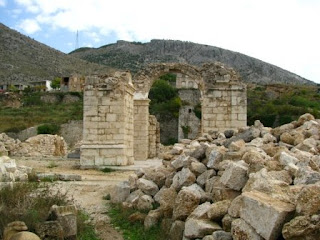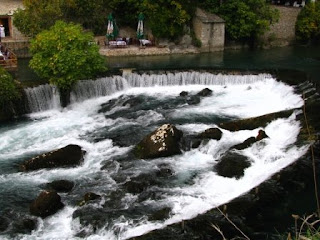The second day, one of the girls, Rachel and I decided to let Majda bring us on a day trip around Mostar and its surrounding region. Of course, it is not for free, but the tour did not cost much and more importantly, it was just the two of us, so Majda was able to give us a very “localized” day tour. We first went up a hill overlooking Mostar. There used to be a big church here, but it was of course, reduced to rubble during the war. The locals tried to raise money to rebuild the church, but they just could not raise enough money, hence reconstruction plans were abandoned before it could even properly start. From the hill, you can get a good view of the city and it was hard not to notice how many buildings in ruins there are.



 紧接着,Majda说要带我们到郊外去野餐。不过在离开之前,我们先到当地一个小餐馆去,购买巴尔干人最爱吃的burek。Majda说,这家餐馆制作的burek是莫斯塔尔最好吃的,餐馆劳保还让我们到厨房去看burek的制作过程。基本上,burek可以当作正餐来吃,里头的馅料可以是马铃薯、芝士或是肉,一片只要2.50新元。我选择了马铃薯馅料的,果然很美味,尤其是我们买的是刚出炉的,整个车子都是burek的香味!
紧接着,Majda说要带我们到郊外去野餐。不过在离开之前,我们先到当地一个小餐馆去,购买巴尔干人最爱吃的burek。Majda说,这家餐馆制作的burek是莫斯塔尔最好吃的,餐馆劳保还让我们到厨房去看burek的制作过程。基本上,burek可以当作正餐来吃,里头的馅料可以是马铃薯、芝士或是肉,一片只要2.50新元。我选择了马铃薯馅料的,果然很美味,尤其是我们买的是刚出炉的,整个车子都是burek的香味!Next, Majda said we will be going for a picnic in the countryside. Since it was supposed to be a picnic, we, of course, need to have some food. Majda brought us to one of the local restaurants and told us that this restaurant served the best burek, a Balkan favorite, in the whole Mostar. Majda asked for permission from the restaurant and we were allowed to take a peek in the kitchen to see how burek as made. One can choose between burek with potato filling, the cheese or the meat type, with each piece of burek costing only 2.50 SGD. As the ones we bought were hot off the rack, we could hardly wait to sink teeth into it as the smell of the burek permeates the whole car.

 Majda带我们到莫斯塔尔邻近的一个小村子去,原来Majda一家在这里拥有个一度假屋,而屋子就面向一条小河。我们坐在河边,一边吃着美味的burek,一边享受着周边的美景。坐在那片宁静中,你很容易忘记这里在十多年前才刚刚经历战争,直到你回头望着身后的废墟时,你才会被提醒这个国家和人民但是所经历的痛苦。
Majda带我们到莫斯塔尔邻近的一个小村子去,原来Majda一家在这里拥有个一度假屋,而屋子就面向一条小河。我们坐在河边,一边吃着美味的burek,一边享受着周边的美景。坐在那片宁静中,你很容易忘记这里在十多年前才刚刚经历战争,直到你回头望着身后的废墟时,你才会被提醒这个国家和人民但是所经历的痛苦。Majda drove us to a village just outside Mostar. Turned out that Majda’s family actually has a summer house here, directly facing this little river that runs through the village. We sat on the river bank, slowly munching on our bureks while admiring the beautiful scenery at the same time. Sitting in that peaceful surroundings, with the quiet only broken by the chirps of the birds, it is really hard to imagine that this country was in turmoil just less than 20 years ago. But the moment you turn your back against the river, the house in ruins right in front of you reminds one never to take peace for granted.




 随后我们又开往另一个小村子,途中我们在一个坟场逗留了几分钟。这个坟场有个纪念碑,纪念在战争时期阵亡的人。仔细研究碑上的名字,会发现一部分的人的名字旁边只有出生日期,没有死亡日期。Majda解释,这些人确实已经不在了,当因为找不到他们的尸首,因为无法列出他们的死亡日期。
随后我们又开往另一个小村子,途中我们在一个坟场逗留了几分钟。这个坟场有个纪念碑,纪念在战争时期阵亡的人。仔细研究碑上的名字,会发现一部分的人的名字旁边只有出生日期,没有死亡日期。Majda解释,这些人确实已经不在了,当因为找不到他们的尸首,因为无法列出他们的死亡日期。After the enjoyable picnic, we then headed for another village. On the way there, we stopped by a small cemetery. The cemetery was not that big, but there was a memorial dedicated to those who perished in the war. On close examination, you will find that on the stones where the names of victims were carved, there were some where their dates of birth were listed, but not their dates of death. Majda explained that these were people who had perished in the war, but because their bodies were never found, nobody was sure when they had died, hence, they had to leave the dates blank.


 我们来到的小村子其实是当地的旅游景点之一,因为这里也有个漂亮的小河,周围环境清幽,所以当地人很喜欢到这里度假。我们就碰到了一群学生随着老师到那里郊游,当他们看到我这个亚洲人时都感到很好奇,频频要求与我合照,还问了一堆的问题。
我们来到的小村子其实是当地的旅游景点之一,因为这里也有个漂亮的小河,周围环境清幽,所以当地人很喜欢到这里度假。我们就碰到了一群学生随着老师到那里郊游,当他们看到我这个亚洲人时都感到很好奇,频频要求与我合照,还问了一堆的问题。The village that we went to is quite a popular destination for locals as there is a beautiful river running through the village and the surrounding region was quite scenic and peaceful. In fact, we saw a few groups of students on a day excursion to the village. When the kids saw us, they were really excited. They were especially fascinated with this Asian since they hardly get to meet one, and I was bombarded with questions and requests for photographs.












 这里吸引游客的另一个理由是,这儿有个拥有400年历史的土尔其屋。这个屋子曾是当地回教徒聚集念经的地方,因为四周被高山围绕着,当年塞尔维亚人轰炸这一带时,这个土尔其屋丝毫不损,因此现在你看到的一切和400年前的一样。因为被回教徒视为神圣地,进入里头参观的人必须依照回教礼仪,穿着得保守,女生则必须裹着头巾。如果事先没有准备,不必担心,你可以向负责人借个头巾。
这里吸引游客的另一个理由是,这儿有个拥有400年历史的土尔其屋。这个屋子曾是当地回教徒聚集念经的地方,因为四周被高山围绕着,当年塞尔维亚人轰炸这一带时,这个土尔其屋丝毫不损,因此现在你看到的一切和400年前的一样。因为被回教徒视为神圣地,进入里头参观的人必须依照回教礼仪,穿着得保守,女生则必须裹着头巾。如果事先没有准备,不必担心,你可以向负责人借个头巾。The main attraction in this village is this Turkish house which is 400 years old. This Turkish house has always served as a place of meditation for the locals. Due to the fact that it was surrounded by high mountains, this Turkish house was able to escape damage during heavy bombing by the Serbs. Since it is considered a holy site by the locals, visitors have to observe Muslim customs and dress conservatively and put on a headscarf prior to entering it. If you do not have a headscarf with you, do not worry. You can get one at the reception for free.






 参观完土尔其屋后,我们坐在户外的咖啡座,享受一杯下午茶。先前不是说过波斯尼亚人很喜欢喝咖啡吗?其实在这里喝咖啡还要有一定的学问,不是像我们平时那样,咕噜咕噜地喝下去。波斯尼亚咖啡是一小壶一小壶的,咖啡上要有一层的泡沫才算是好咖啡。随着咖啡一起端上来的是两小块白糖、一小块甜糕点和一杯开水。将咖啡倒入小杯子后,拿起白糖,粘点咖啡,将白糖含在口中,再慢慢喝一口咖啡,细细品尝,直到白糖溶化在咖啡中后,再把咖啡吞入肚。看,是不是很讲究啊?
参观完土尔其屋后,我们坐在户外的咖啡座,享受一杯下午茶。先前不是说过波斯尼亚人很喜欢喝咖啡吗?其实在这里喝咖啡还要有一定的学问,不是像我们平时那样,咕噜咕噜地喝下去。波斯尼亚咖啡是一小壶一小壶的,咖啡上要有一层的泡沫才算是好咖啡。随着咖啡一起端上来的是两小块白糖、一小块甜糕点和一杯开水。将咖啡倒入小杯子后,拿起白糖,粘点咖啡,将白糖含在口中,再慢慢喝一口咖啡,细细品尝,直到白糖溶化在咖啡中后,再把咖啡吞入肚。看,是不是很讲究啊? After the tour of the Turkish house, we sat down for afternoon tea. Remember I said that Bosnians love their coffee? Drinking coffee is actually an art here. One does not down coffee the normal way here. Coffee is served in tiny pots here. Along with your little pot of coffee, which is served with a thick layer of foam (only then is it considered good coffee!), you will get a tiny teacup, two cubes of sugar, a sweet dessert and a glass of water. To start, you first dip a cube of sugar into the coffee. Next, hold the sugar in your mouth. Then take a sip of coffee, making sure the sugar dissolves before swallowing the coffee. This is the true Bosnian way of drinking coffee.



 一日游结束后,再到莫斯塔尔古镇以外的地方走走。对这里的其中一条主要街道留下深刻的印象,因为这里在战争时期被视为莫斯塔尔的前线,是塞尔维亚军队轰炸最猛的地方,也就所以你在这里会看到一座又一座破损的建筑。
一日游结束后,再到莫斯塔尔古镇以外的地方走走。对这里的其中一条主要街道留下深刻的印象,因为这里在战争时期被视为莫斯塔尔的前线,是塞尔维亚军队轰炸最猛的地方,也就所以你在这里会看到一座又一座破损的建筑。After the tour ended, we walked around the parts of the town outside Old Town. On one of the main street, you will notice a lot more ruined buildings than other parts of the town. This was where the frontline of the city was during the war. Buildings on this stretch of road were heavily shelled, including schools.




 这和莫斯塔尔的新镇形成了很大的对比,在这里你可以看到新颖的咖啡座,时髦的购物中心和超市。原本以为莫斯塔尔是个没有太多人的小镇,后来才发现并不是如此,原来当地人都不到古镇去,而是全都聚集在新镇那里喝咖啡和购物。
这和莫斯塔尔的新镇形成了很大的对比,在这里你可以看到新颖的咖啡座,时髦的购物中心和超市。原本以为莫斯塔尔是个没有太多人的小镇,后来才发现并不是如此,原来当地人都不到古镇去,而是全都聚集在新镇那里喝咖啡和购物。This is a huge contrast to the new part of the town where you hardly see any ruined buildings. Here you find modern shopping malls, albeit a bit smaller than those you will find in huge, modern cities. And of course, there are huge supermarkets and up-market cafes and restaurants too. Here is where the huge majority of the locals hang out.


 喜欢波黑除了因为它的历史让它变得有趣和它那漂亮的风景之外,更喜欢它的物价。住宿方面,一般只需要掏出10欧元(20新元)就有地方落脚。食物方面,只需区区的1.50欧元(3新元),就可以买到美味的鸡柳、薯条、沙拉和水。和其他东欧国家比起来,这里真的便宜多了。所以说,如果想要“感受”东欧的历史,那来亲切的波黑一游准没错!
喜欢波黑除了因为它的历史让它变得有趣和它那漂亮的风景之外,更喜欢它的物价。住宿方面,一般只需要掏出10欧元(20新元)就有地方落脚。食物方面,只需区区的1.50欧元(3新元),就可以买到美味的鸡柳、薯条、沙拉和水。和其他东欧国家比起来,这里真的便宜多了。所以说,如果想要“感受”东欧的历史,那来亲切的波黑一游准没错!Other than its history and beautiful scenery, the other thing about Bosnia and Hercegovina that appealed to me is its cost of living. For just 10 Euros (20 SGD), you will be able to find a bed in a hostel, sometimes with breakfast thrown in. As for food, a mere 1.50 Euros (3 SGD) can buy you a chicken fillet, complete with fries, salad and a drink. Compared to the other Eastern European countries, Bosnia & Hercegovina is much easier on the pockets. So, if you are looking for the Balkan experience, then come to this lovely country!

1 comment:
i want the burek with potato filling pls!! Looks so yum!
And the 小村子 really looks so special, they have a mini 'niagara falls' also hehe
Is that how turkish coffee is drunk too?
Post a Comment